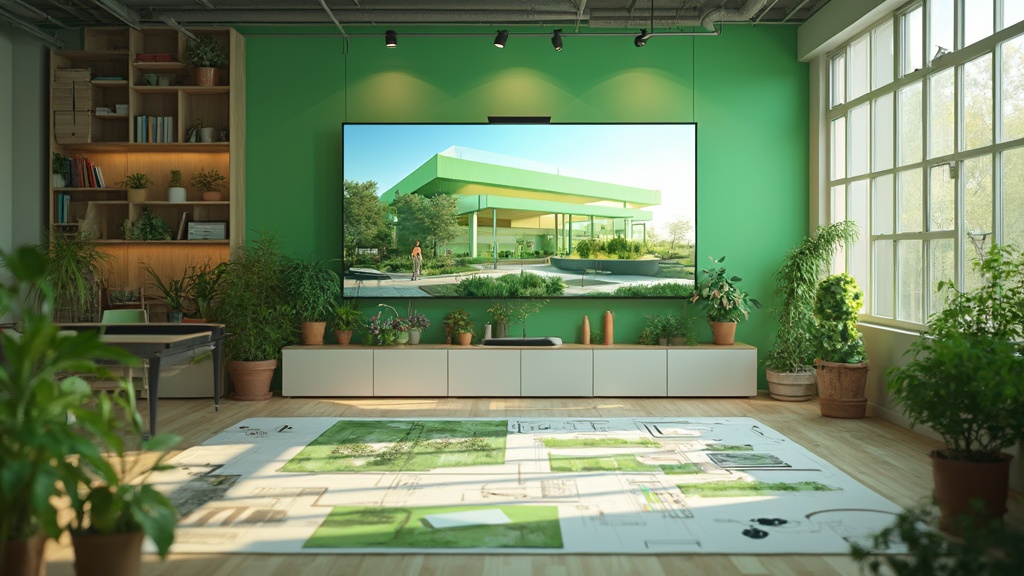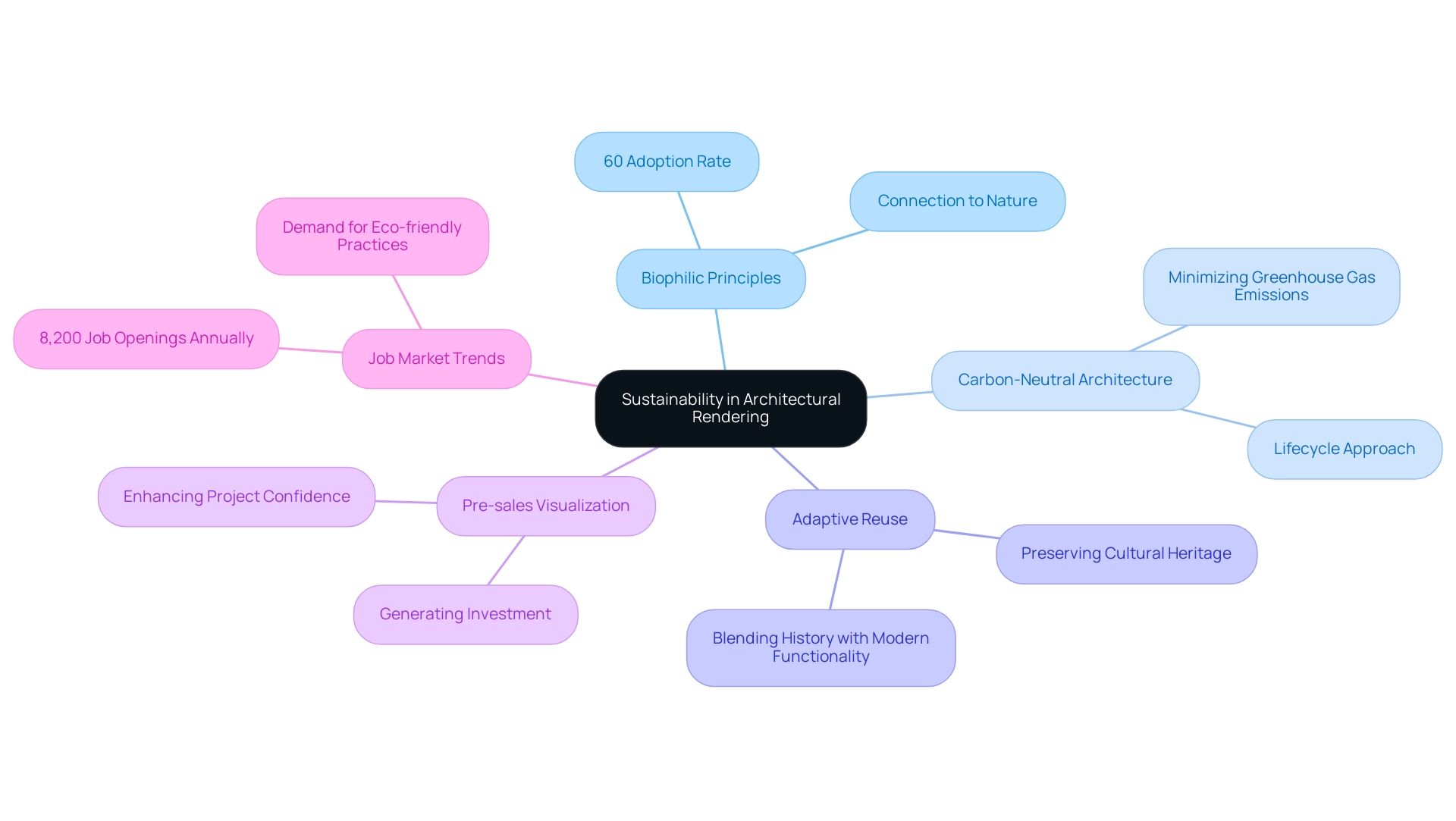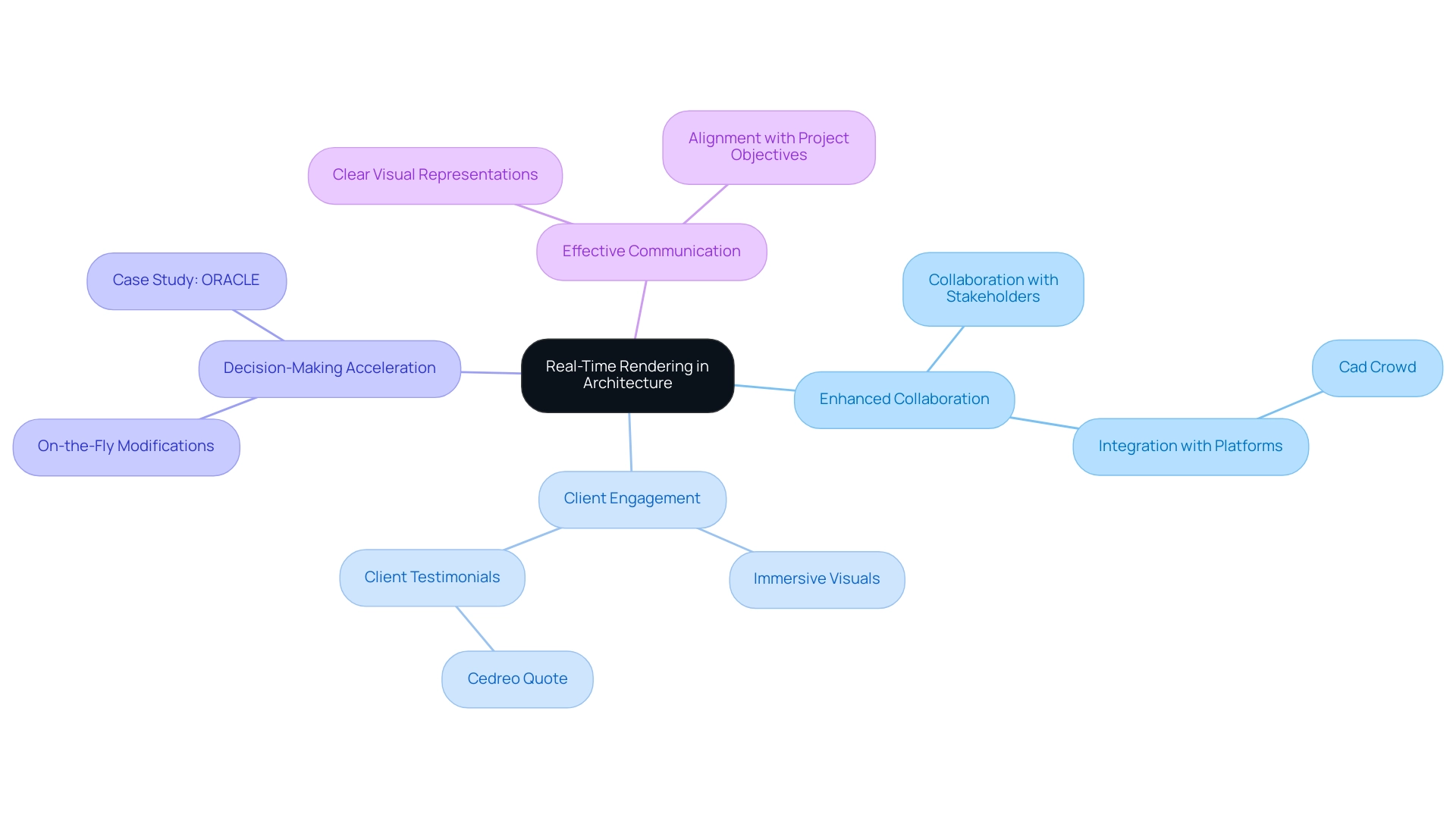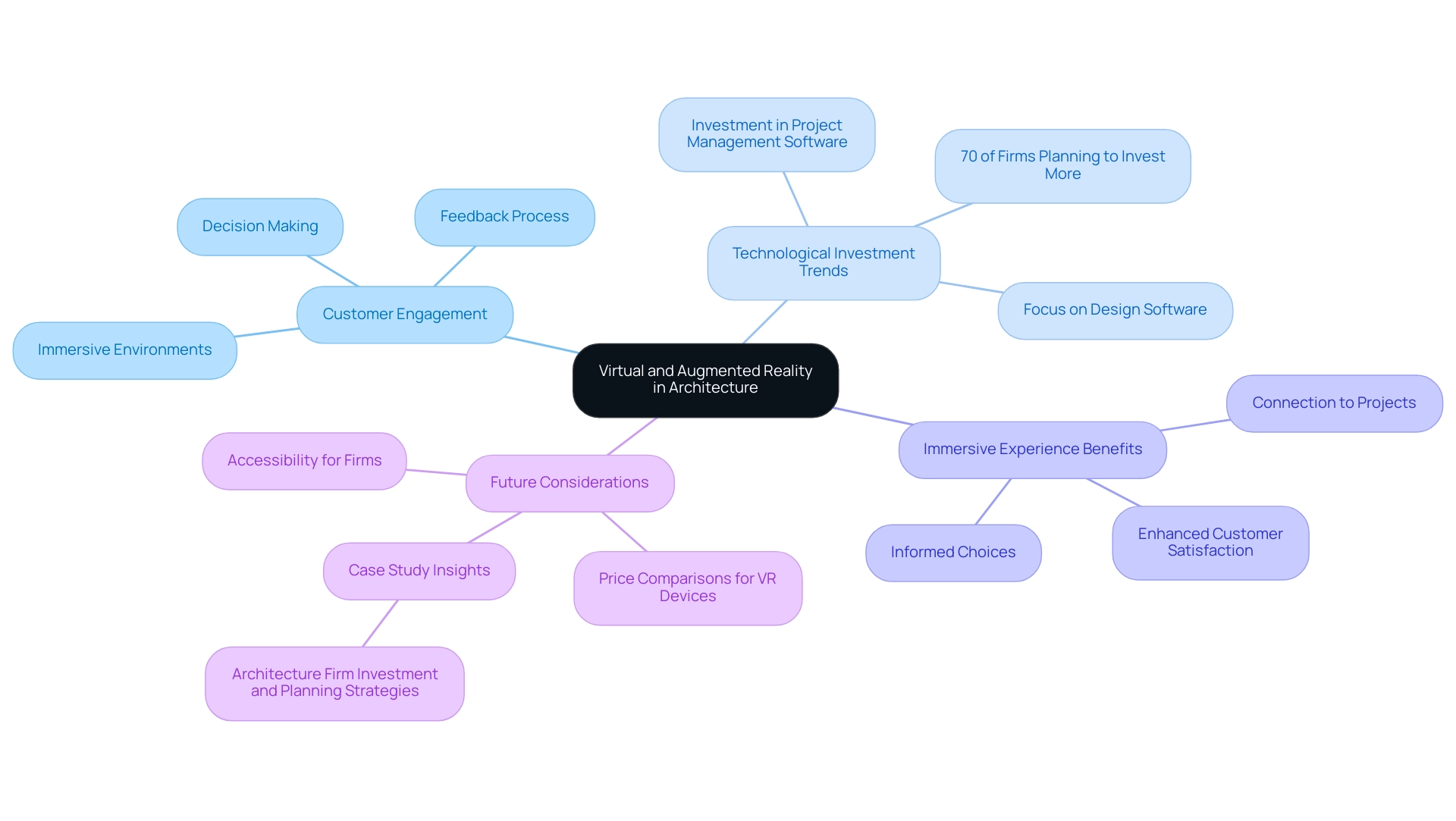Overview:
The top trends in 3D architectural renderings for 2025 include the integration of AI for enhanced creativity and efficiency, a focus on sustainability through eco-friendly practices, and the use of real-time rendering and immersive technologies like virtual and augmented reality to improve client engagement. The article supports this by detailing how these advancements not only streamline the design process and foster collaboration but also align with growing market demands for realistic, sustainable, and visually compelling architectural solutions.
Introduction
The architectural landscape is undergoing a profound transformation, driven by the integration of advanced technologies that enhance visualization and client engagement. As artificial intelligence, real-time rendering, and immersive virtual environments become pivotal in architectural practices, architects are empowered to push the boundaries of creativity and precision.
This article delves into the revolutionary impact of AI on rendering processes, the shift towards sustainable practices, and the emergence of real-time collaboration tools, all of which are redefining how architects approach design. By exploring the importance of realistic textures and materials, as well as the role of virtual and augmented reality in client interactions, a comprehensive understanding of these innovations will be established.
As the industry evolves, these advancements not only respond to the growing demands of clients but also set the stage for a future where architectural visualization aligns seamlessly with both aesthetic aspirations and functional requirements.
AI Integration: Revolutionizing Architectural Renderings
The integration of artificial intelligence has become essential in the realm of architectural visualization, providing designers with powerful tools to enhance both creativity and efficiency. Generative creation algorithms exemplify this trend, enabling architects to rapidly explore a diverse array of options while optimizing for aesthetics and functionality. This approach not only expedites the design process but also permits a deeper exploration of innovative solutions.
Furthermore, AI-driven visualization software excels in predicting lighting conditions and material behaviors, significantly diminishing the time required for adjustments and iterations. As we approach 2025, the pervasive use of AI is set to transform the visualization landscape, highlighting the best trends in 3D architectural renderings for 2025, ensuring that visualizations are increasingly aligned with client expectations and real-world conditions. In this context, preliminary conceptual illustrations play a crucial role:
- They offer quick visualizations that facilitate early-stage decision-making.
- They are cost-effective for initial explorations.
- They enhance communication among stakeholders.
Furthermore, these representations facilitate a repetitive creation process, enabling designers to enhance their concepts through numerous alterations informed by input. The capability to produce various layout alternatives within 24 hours enables architects to investigate a broader spectrum of creative possibilities without sacrificing accuracy. This capability underscores the transformative potential of AI in the industry, especially as pre-sales visualization emerges as a strategic asset that can ignite interest and investment long before the physical project materializes.
By acting as a tangible asset, visualizations can effectively generate crucial revenue for construction. Statistics indicate that the global digital asset management market, a critical component of this evolution, was valued at $3.96 billion in 2023, with projections to reach $16.18 billion by 2032. Additionally, the architecture industry has experienced a growth rate of 1.6% CAGR between 2019 and 2024, highlighting the increasing relevance of AI integration in architectural practices, supported by approximately 6,000 graduates from architectural programs each year, ready to leverage these advancements.
Sustainability in Focus: Eco-Friendly Rendering Practices
Sustainability is increasingly influencing architectural creation, leading to the emergence of the best trends in 3D architectural renderings for 2025. Architects are now prioritizing eco-friendly materials and techniques in their visualizations, ensuring that their creations achieve aesthetic appeal while aligning with sustainable principles. Cinthya Soto emphasizes this shift, stating,
Carbon-neutral architecture focuses on minimizing or eliminating greenhouse gas emissions throughout a building’s lifecycle.
This focus is exemplified by the increasing incorporation of biophilic principles, which fosters a connection between natural environments and constructed spaces; recent statistics reveal that biophilic approaches have been adopted in over 60% of new architectural projects, reflecting their growing importance. Detailed renderings are essential in highlighting the best trends in 3D architectural renderings for 2025, as they showcase the visual appeal of materials while also evoking emotions and resonating with the lifestyles of potential homeowners. For instance, the interplay of natural light on textured surfaces can create inviting atmospheres that enhance the overall design narrative.
Furthermore, the role of pre-sales visualization has become crucial, serving as a bridge to enhance project confidence and generate investment. The practice of adaptive reuse has also become standard in the industry, allowing designers to repurpose existing structures for modern use while preserving cultural heritage. A case study titled ‘Emphasizing the Importance of Adaptive Reuse’ highlights this trend, showcasing how designers blend history with modern functionality to meet changing needs.
By utilizing sophisticated software that precisely mimics natural illumination and material characteristics, designers can produce intricate visuals that exemplify the best trends in 3D architectural renderings for 2025, enhancing sustainability and connecting profoundly with environmentally aware customers. As the demand for these innovative practices increases, the architectural sector expects around 8,200 job openings each year over the next ten years, highlighting the significance of adopting eco-friendly visualization methods to satisfy changing market requirements.
Real-Time Rendering: Enhancing Collaboration and Feedback
Real-time visualization is fundamentally changing architectural teamwork, enabling designers to engage with customers and stakeholders while highlighting the best trends in 3D architectural renderings for 2025 in unprecedented ways. By utilizing advanced rendering engines, architects can incorporate the best trends in 3D architectural renderings for 2025, providing instant visual feedback and significantly enhancing client engagement throughout the creation process. This innovative technology facilitates on-the-fly modifications, which exemplify the best trends in 3D architectural renderings for 2025, fostering a dynamic and interactive experience.
Clients benefit from the ability to visualize modifications in real-time, which accelerates decision-making and enriches their design journey by implementing the best trends in 3D architectural renderings for 2025. As one pleased customer remarked, ‘The immediate visualization enabled us to witness our concepts materialize quickly, facilitating our decision-making process.’ Moreover, the integration of client testimonials underscores the reliability and satisfaction that J. Scott Smith Visual Designs has cultivated, showcasing a commitment to exceeding expectations.
The display of the best trends in 3D architectural renderings for 2025, featuring immersive and high-quality visuals during meetings, enhances communication and ensures that all parties stay aligned with project objectives. As Cedreo aptly notes, ‘No other program allows you to progress from a blank project to a fully furnished home complete with 2D plans and 3D visuals in just a few hours.’ Incorporating real-time visual processes with collaboration platforms such as Cad Crowd further enhances the best trends in 3D architectural renderings for 2025, improving the aesthetic, functionality, and sustainability of creations.
For instance, the successful collaboration with ORACLE demonstrates how real-time visualization technology aids in informed decision-making, showcasing the professionalism and expertise that can lead to satisfying outcomes for all stakeholders involved. Additionally, incorporating the best trends in 3D architectural renderings for 2025 improves communication with builders, lenders, and municipalities by providing clear visual representations of projects, reducing misunderstandings and ensuring that everyone involved has a shared understanding of the design intent.
Virtual and Augmented Reality: Transforming Client Engagement
The integration of virtual and augmented reality technologies is revolutionizing customer engagement by highlighting the best trends in 3D architectural renderings for 2025. By crafting immersive environments, architects can transport individuals into their future spaces, creating a sense of presence that traditional methods simply cannot offer. This interaction not only improves understanding but also motivates customers to give detailed feedback, ultimately resulting in more informed choices regarding development.
For example, our joint creation phase includes producing initial renderings that mirror customer input, ensuring that each iteration corresponds with their vision through a systematic process of modifications and enhancements based on feedback. As companies increasingly embrace VR headsets, customers can explore the best trends in 3D architectural renderings for 2025, allowing them to experience the intricacies of spatial relationships and aesthetic components firsthand. Such immersive experiences foster a profound connection to the project, significantly impacting decision-making processes and enhancing overall customer satisfaction.
Notably, industry trends indicate that 70% of architecture firms plan to elevate their technological investments in the coming year by focusing on the best trends in 3D architectural renderings for 2025, including advancements like project management and design software. This shift reflects a broader recognition of leveraging cutting-edge tools to enhance customer engagement and satisfaction. The role of pre-sales visualization plays a crucial part in this process, serving as a bridge between concept and reality while generating revenue for construction by attracting interest and investment, particularly by showcasing the best trends in 3D architectural renderings for 2025 long before the physical manifestation of the project.
Furthermore, as we look to the future, price comparisons for devices such as the Meta Quest and Apple Vision Pro for 2024 will likely influence accessibility for firms aiming to adopt these technologies. The case study titled ‘Architecture Firm Investment and Planning Strategies’ illustrates how firms are planning to modernize and invest in technology, emphasizing the significance of techniques in successful client collaboration.
Achieving Realism: The Importance of Textures and Materials
The realism of architectural visuals is fundamentally influenced by the quality of textures and materials employed. High-resolution textures that authentically replicate real-world surfaces significantly enhance the visual impact of an image. It is crucial for architects, especially lead architects focused on capturing the essence of their creations, to meticulously select materials, ensuring they accurately reflect the characteristics of their real-life counterparts.
Techniques such as bump mapping and displacement mapping are essential for adding depth and realism to surfaces, resulting in lifelike appearances. As we approach 2025, the demand for lifelike representations is expected to intensify, highlighting the best trends in 3D architectural renderings for 2025, driven by clients’ growing expectations for visualizations that closely mirror the final constructed environments. The function of thorough illustrations in visualizing and enhancing residential architecture concepts cannot be overstated; they not only improve stakeholder communication but also help in identifying issues early in the process.
In fact, as reported by The Architect’s Newspaper, there were 35,621 candidates actively pursuing licensure in 2022, emphasizing the architectural field’s focus on mastering these illustration techniques to enhance presentations. Furthermore, with the architecture sector experiencing a steady growth rate of 1.6% CAGR from 2019 to 2024, the integration of AI-powered architectural visualization programs like Midjourney and Adobe Firefly is becoming increasingly important, enhancing productivity and creativity in design through meticulous attention to detail. To achieve the desired realism, designers must carefully consider the level of detail in their renderings, ensuring that every aspect, from textures to lighting, is thoughtfully executed.
Practical application of these principles can be found in user manuals that guide architects on selecting appropriate levels of detail based on project requirements and client expectations.
Conclusion
The architectural landscape is undergoing a transformative shift, fueled by advanced technologies that enhance creativity, efficiency, and client engagement. The integration of artificial intelligence in rendering processes allows architects to rapidly explore innovative design solutions while optimizing aesthetics and functionality, ensuring visualizations meet client expectations and real-world conditions.
Sustainability has become a cornerstone of architectural design, leading to the adoption of eco-friendly materials and practices. The rise of biophilic design and adaptive reuse demonstrates a commitment to minimizing environmental impact while creating visually compelling spaces. Utilizing advanced software to simulate natural elements enables architects to produce detailed renderings that resonate with environmentally conscious clients.
Additionally, real-time rendering and immersive technologies, such as virtual and augmented reality, are revolutionizing collaboration and client engagement. These innovations facilitate dynamic interactions and immediate feedback, allowing clients to visualize changes in real-time and deepening their connection to projects. The focus on realistic textures and materials remains essential, as they enhance the visual narrative of designs.
In conclusion, the future of architectural visualization lies in the integration of technology, sustainability, and realism. As architects leverage these advancements, they can create spaces that are both aesthetically pleasing and functionally superior. This evolution not only addresses client demands but also fosters a more innovative and responsible approach to architecture, setting the stage for a transformative future.






0 Comments